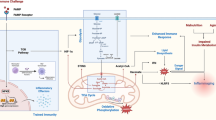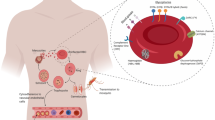Abstract
The malaria parasite, Plasmodium , has evolved an intricate life cycle that includes stages specific to a mosquito vector and to the vertebrate host. The mosquito midgut represents the first barrier Plasmodium parasites encounter following their ingestion with a blood meal from an infected vertebrate. Elucidation of the molecular interaction between the parasite and the mosquito could help identify novel approaches to preventing parasite development and subsequent transmission to vertebrates. We have used an integrated Bulked Segregant Analysis-Differential Display (BSA-DD) approach to target genes expressed that are in the midgut and located within two genome regions involved in determining susceptibility to P. gallinaceum in the mosquito Aedes aegypti. A total of twenty-two genes were identified and characterized, including five genes with no homologues in public sequence databases. Eight of these genes were mapped genetically to intervals on chromosome 2 that contain two quantitative trait loci (QTLs) that determine susceptibility to infection by P. gallinaceum. Expression analysis revealed several expression patterns, and ten genes were specifically or preferentially expressed in the midgut of adult females. Real-time PCR quantification of expression with respect to the time of blood meal ingestion and infection status in mosquito strains permissive and refractory for malaria revealed a differential expression pattern for seven genes. These represent candidate genes that may influence the ability of the mosquito vector to support the development of Plasmodium parasites. Here we describe their isolation and discuss their putative roles in parasite-mosquito interactions and their use as potential targets in strategies designed to block transmission of malaria.





Similar content being viewed by others
References
Akey JM, Sosnoski D, Parra E, Dios S, Hiester K, Su B, Bonilla C, Jin L, Shriver MD (2001) Melting curve analysis of SNPs (McSNP): a gel-free and inexpensive approach for SNP genotyping. Biotechniques 30:358–367
Altschul SF, Madden TL, Schaffer AA, Zhang J, Zhang Z, Miller W, Lipman DJ (1997) Gapped BLAST and PSI-BLAST: a new generation of protein database search programs. Nucleic Acids Res 25:3389–3402
Arca B, Lombardo F, de Lara Capurro M, della Torre A, Dimopoulos G, James AA, Coluzzi M (1999) Trapping cDNAs encoding secreted proteins from the salivary glands of the malaria vector Anopheles gambiae. Proc Natl Acad Sci USA 96:1516–1521
Bertioli DJ, Schlichter UHA, Adams MJ, Burrows PK, Steinbiss HH, Antoniw JF (1995) An analysis of differential display shows a strong bias towards high copy number messenger RNAs. Nucleic Acids Res 23:4520–4523
Catteruccia F, Nolan T, Blass C, Muller HM, Crisanti A, Kafatos FC, Loukeris TG (2000) Toward Anopheles transformation: Minos element activity in anopheline cells and embryos. Proc Natl Acad Sci USA 97:2157–2162
Coates CJ (2000) Malaria. A mosquito transformed. Nature 405:900–901
Crabb JW, Carlson A, Chen Y, Goldflam S, Intres R, West KA, Hulmes JD, Kapron JT, Luck LA, Horwitz J, Bok D (1998) Structural and functional characterization of recombinant human cellular retinaldehyde-binding protein. Protein Sci 7:746–757
Delmas B, Gelfi J, L'Haridon R, Vogel LK, Sjostrom H, Noren O, Laude H (1992) Aminopeptidase N is a major receptor for the entero-pathogenic coronavirus TGEV. Nature 357:417–420
Dessens JT, Beetsma AL, Dimopoulos G, Wengelnik K, Crisanti A, Kafatos FC, Sinden RE (1999) CTRP is essential for mosquito infection by malaria ookinetes. EMBO J 18:6221–6227
Dimopoulos G, Richman A, della Torre A, Kafatos FC, Louis C (1996) Identification and characterization of differentially expressed cDNAs of the vector mosquito, Anopheles gambiae. Proc Natl Acad Sci USA 93:13066–13071
Dimopoulos G, Seeley D, Wolf A, Kafatos FC (1998) Malaria infection of the mosquito Anopheles gambiae activates immune- responsive genes during critical transition stages of the parasite life cycle. EMBO J 17:6115–6123
Dimopoulos G, Muller HM, Levashina EA, Kafatos FC (2001) Innate immune defense against malaria infection in the mosquito. Curr Opin Immunol 13:79–88
Dunkov BC, Zhang D, Choumarov K, Winzerling JJ, Law JH (1995) Isolation and characterization of mosquito ferritin and cloning of a cDNA that encodes one subunit. Arch Insect Biochem Physiol 29:293–307
Feldmann AM, Billingsley PF, Savelkoul E (1990) Bloodmeal digestion by strains of Anopheles stephensi Liston (Diptera: Culicidae) of differing susceptibility to Plasmodium falciparum. Parasitology 101:193–200
Feyereisen R (1999) Insect P450 enzymes. Annu Rev Entomol 44:507–533
Ghosh A, Edwards MJ, Jacobs-Lorena M (2000) The journey of the malaria parasite in the mosquito: hopes for the new century. Parasitol Today 16:196–201
Giugni TD, Soderberg C, Ham DJ, Bautista RM, Hedlund KO, Moller E, Zaia JA (1996) Neutralization of human cytomegalovirus by human CD13-specific antibodies. J Infect Dis 173:1062–1071
Hoffmann JA (1995) Innate immunity of insects. Curr Opin Immunol 7:4–10
Huber M, Cabib E, Miller LH (1991) Malaria parasite chitinase and penetration of the mosquito peritrophic membrane. Proc Natl Acad Sci USA 88:2807–2810
Hultmark D (1993) Immune reactions in Drosophila and other insects: a model for innate immunity. Trends Genet 9:178–83.
Jasinskiene N, Coates CJ, Benedict MQ, Cornel AJ, Rafferty CS, James AA, Collins FH (1998) Stable transformation of the yellow fever mosquito, Aedes aegypti , with the Hermes element from the housefly. Proc Natl Acad Sci USA 95:3743–3747
Jiang Q, Hall M, Noriega FG, Wells M (1997) cDNA cloning and pattern of expression of an adult, female-specific chymotrypsin from Aedes aegypti midgut. Insect Biochem Mol Biol 27:283–289
Kokoza V, Ahmed A, Cho WL, Jasinskiene N, James AA, Raikhel A (2000) Engineering blood meal-activated systemic immunity in the yellow fever mosquito, Aedes aegypti. Proc Natl Acad Sci USA 97:9144–9149
Kosambi DD (1944) The estimation of map distance from recombination values. Ann Eugen 12:172–175
Lander ES, Green P, Abrahamson J, Barlow A, Daly MJ, Lincoln SE, Newburg L (1987) MAPMAKER: an interactive computer package for constructing primary genetic linkage maps of experimental and natural populations. Genomics 1:174–181
Ledakis P, Tanimura H, Fojo T (1998) Limitations of differential display. Biochim Biophys Res Comm 251:653–656
Liang P, Pardee AB (1992) Differential display of eukaryotic messenger RNA by means of the polymerase chain reaction. Science 257:967–971
Lincoln SE, Lander ES (1990) Mapping genes controlling quantitative traits using MAPMAKER/QTL. Whitehead Institute for Biomedical Research, Cambridge, Mass.
Luckhart S, Vodovotz Y, Cui L, Rosenberg R (1998) The mosquito Anopheles stephensi limits malaria parasite development with inducible synthesis of nitric oxide. Proc Natl Acad Sci USA 95:5700–5705
Moreira LA, Edwards MJ, Adhami F, Jasinskiene N, James AA, Jacobs-Lorena M (2000) Robust gut-specific gene expression in transgenic Aedes aegypti mosquitoes. Proc Natl Acad Sci USA 97:10895–10898
Morlais I, Severson DW (2001) Identification of a polymorphic mucin-like gene expressed in the midgut of the mosquito, Aedes aegypti , using an integrated bulked segregant and differential display analysis. Genetics 158:1125–1136
Muller HM, Catteruccia F, Vizioli J, della Torre A, Crisanti A (1995) Constitutive and blood meal-induced trypsin genes in Anopheles gambiae. Exp Parasitol 81:371–385
Nakanishi K, Yaoi K, Nagino Y, Hara H, Kitami M, Atsumi S, Miura N, Sato R (2002) Aminopeptidase N isoforms from the midgut of Bombyx mori and Plutella xylostella —their classification and the factors that detrmine their binding specificity to Bacillus thuringiensis CryIA toxin. FEBS Lett 519:215–220
Nielsen H, Engelbrecht J, Brunak S, von Heijne G (1997) Identification of prokaryotic and eukaryotic signal peptides and prediction of their cleavage sites. Protein Eng 10:1–6
Oduol F, Xu J, Niare O, Natarajan R, Vernick KD (2000) Genes identified by an expression screen of the vector mosquito Anopheles gambiae display differential molecular immune response to malaria parasites and bacteria. Proc Natl Acad Sci USA 97:11397–11402
Oppermann UC, Filling C, Jornvall H (2001) Forms and functions of human SDR enzymes. Chem Biol Interact 130–132:699–705
Pautot V, Holzer FM, Reisch B, Walling LL (1993) Leucine aminopeptidase—an inducible component of the defense response in Lycopersicon esculentum (tomato). Proc Natl Acad Sci USA 90:9906–9910
Pomes A, Melen E, Vailes LD, Retief JD, Arruda LK, Chapman MD (1998) Novel allergen structures with tandem amino acid repeats derived from German and American cockroach. J Biol Chem 273:30801–30807
Richards AG, Richards PA (1977) The peritrophic membranes of insects. Annu Rev Entomol 22:219–240
Richman AM, Dimopoulos G, Seeley D, Kafatos FC (1997) Plasmodium activates the innate immune response of Anopheles gambiae mosquitoes. EMBO J 16:6114–6119
Rose RL, Goh D, Thompson DM, Verma KD, Heckel DG, Gahan LJ, Roe RM, Hodgson E (1997) Cytochrome P450 (CYP)9A1 in Heliothis virescens: the first member of a new CYP family. Insect Biochem Mol Biol 27:605–615
Rosenfeld A, Vanderberg JP (1999) Plasmodium berghei: induction of aminopeptidase in malaria-resistant strain of Anopheles gambiae. Exp Parasitol 93:101–104
Schmid KJ, Tautz D (1997) A screen for fast evolving genes from Drosophila. Proc Natl Acad Sci USA 94:9746–9750
Scott JG, Liu N, Wen Z (1998) Insect cytochromes P450: diversity, insecticide resistance and tolerance to plant toxins. Comp Biochem Physiol C Pharmacol Toxicol Endocrinol 121:147–155
Severson DW (1997) RFLP analysis of insect genomes. In: Crampton JM, Beard CB, Louis C (eds) The Molecular biology of insect disease vectors. Chapman and Hall, London, pp 309–320
Severson DW, Thathy V, Mori A, Zhang Y, Christensen BM (1995) Restriction fragment length polymorphism mapping of quantitative trait loci for malaria parasite susceptibility in the mosquito Aedes aegypti. Genetics 139:1711–1717
Severson DW, Meece JK, Lovin DD, Saha G, Morlais I (2002) Linkage map organization of expressed sequence tags and sequence tagged sites in the mosquito, Aedes aegypti. Insect Mol Biol 11:371–378
Shahabuddin M, Criscio M, Kaslow DC (1995) Unique specificity of in vitro inhibition of mosquito midgut trypsin-like activity correlates with in vivo inhibition of malaria parasite infectivity. Exp Parasitol 80:212–219
Shao Z, Cui Y, Liu X, Yi H, Ji J, Yu Z (1998) Processing of delta-endotoxin of Bacillus thuringiensis subsp. kurstaki HD-1 in Heliothis armigera midgut juice and the effects of protease inhibitors. J Invertebr Pathol 72:73–81
Shen Z, Dimopoulos G, Kafatos FC, Jacobs-Lorena M (1999) A cell surface mucin specifically expressed in the midgut of the malaria mosquito Anopheles gambiae. Proc Natl Acad Sci USA 96:5610–5615
Shen Z, Edwards MJ, Jacobs-Lorena M (2000) A gut-specific serine protease from the malaria vector Anopheles gambiae is downregulated after blood ingestion. Insect Mol Biol 9:223–229
Sieber KP, Huber M, Kaslow D, Banks SM, Torii M, Aikawa M, Miller LH (1991) The peritrophic membrane as a barrier: its penetration by Plasmodium gallinaceum and the effect of a monoclonal antibody to ookinetes. Exp Parasitol 72:145–156
Stevens JL, Snyder MJ, Koener JF, Feyereisen R (2000) Inducible P450s of the CYP9 family from larval Manduca sexta midgut. Insect Biochem Mol Biol 30:559–568
Tautz D, Schmid KJ (1998) From genes to individuals: developmental genes and the generation of the phenotype. Philos Trans R Soc Lond B Biol Sci 353:231–240
Tellam RL, Wijffels G, Willadsen P (1999) Peritrophic matrix proteins. Insect Biochem Mol Biol 29:87–101
Thathy V, Severson DW, Christensen BM (1994) Reinterpretation of the genetics of susceptibility of Aedes aegypti to Plasmodium gallinaceum. J Parasitol 80:705–712
Thompson JD, Higgins DG, Gibson TJ (1994) CLUSTAL W: improving the sensitivity of progressive multiple sequence alignment through sequence weighting, position-specific gap penalties and weight matrix choice. Nucleic Acids Res 22:4673–4680
Vinetz JM, Valenzuela JG, Specht CA, Aravind L, Langer RC, Ribeiro JM, Kaslow DC (2000) Chitinases of the avian malaria parasite Plasmodium gallinaceum, a class of enzymes necessary for parasite invasion of the mosquito midgut. J Biol Chem 275:10331–10341
Wu CH, Wang NM, Lee MF, Kao CY, Luo SF (1998) Cloning of the American cockroach Cr-PII allergens: evidence for the existence of cross-reactive allergens between species. J Allergy Clin Immunol 101:832–840
Zieler H, Nawrocki JP, Shahabuddin M (1999) Plasmodium gallinaceum ookinetes adhere specifically to the midgut epithelium of Aedes aegypti by interaction with a carbohydrate ligand. J Exp Biol 202:485–495
Zimmer S, Stocker A, Sarbolouki MN, Spycher SE, Sassoon J, Azzi A (2000) A novel human tocopherol-associated protein: cloning, in vitro expression, and characterization. J Biol Chem 275:25672–25680
Acknowledgements
This work was supported by Grant No. AI33127 from the National Institutes of Health.
Author information
Authors and Affiliations
Corresponding author
Additional information
Communicated by D. Y. Thomas
Rights and permissions
About this article
Cite this article
Morlais, I., Mori, A., Schneider, J.R. et al. A targeted approach to the identification of candidate genes determining susceptibility to Plasmodium gallinaceum in Aedes aegypti . Mol Gen Genomics 269, 753–764 (2003). https://doi.org/10.1007/s00438-003-0882-7
Received:
Accepted:
Published:
Issue Date:
DOI: https://doi.org/10.1007/s00438-003-0882-7




